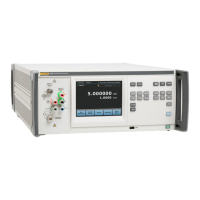Remote Commands
Checking Product Status 6
6-77
Bit Assignments for the ESR and ESE
See Table 6-10 for bit assignments for the ESR and ESE.
Table 6-10. Bit Assignments for ESR and ESE
15 14 13 12 11 10 9 8
0 0 0 0 0 0 0 0
7 6 5 4 3 2 1 0
PON 0 CME EXE DDE QYE 0 OPC
PON
Power on. This bit is set to 1 if line power has been turned off and on since the last time
the ESR was read.
CME
Command error. The Product remote interface encountered and incorrectly formed
command. (The command ERR? fetches the earliest error code in the error queue,
which contains error codes for the first 15 errors that have occurred).
EXE
Execution error. An error occurred while the Product tried to execute the last command.
This could be caused, for example, by a parameter being out of range. (The command
ERR? fetches the earliest error code in the error queue, which contains error codes for
the first 15 errors that have occurred).
DDE Device-dependent error. An error related to a device-dependent command has occurred.
QYE
Query error. The Product was addressed to talk when no response data was available or
appropriate, or when the controller failed to retrieve data on the output queue.
OPC
Operation complete. All commands previous to reception of a *OPC command have
been executed, and the interface is ready to accept another message.
Read the ESR and ESE
To read the contents of the ESR, send the remote command, "*ESR?." The ESR
is cleared (set to 0) every time it is read. To read the contents of the ESE, send
the remote command, "*ESE?." The ESE is not cleared when it is read. When
either register is read, the Product responds by sending a decimal number that
represents bits 0 through 15.
Load the ESE
Resetting the bits in the ESE can mask (disable) the associated bits in the ESR.
For example, to prevent the occurrence of a command error from causing bit 5
(ESB) in the Status Byte Register going to 1, bit 5 in the ESE register can be
reset to 0.
Instrument Status Register (ISR)
The Instrument Status Register (ISR) gives the controller access to the state of
the Product, including some of the information presented to the operator on the
display and the display annunciators during local operation.

